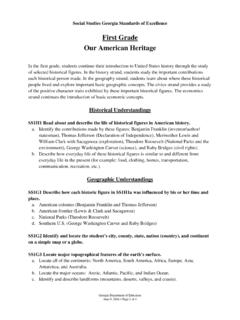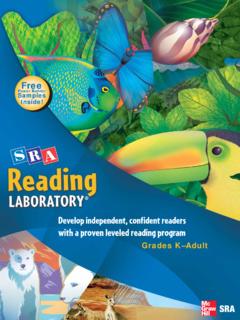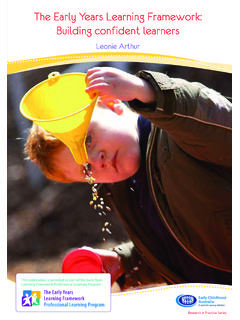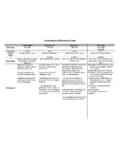Transcription of Georgia Standards of Excellence
1 Georgia Standards of Excellence Mathematics Standards 6th - 8th Grade Georgia Department of Education K-12 Mathematics Introduction The Georgia Mathematics Curriculum focuses on actively engaging the students in the development of mathematical understanding by using manipulatives and a variety of representations, working independently and cooperatively to solve problems, estimating and computing efficiently, and conducting investigations and recording findings. There is a shift towards applying mathematical concepts and skills in the context of authentic problems and for the student to understand concepts rather than merely follow a sequence of procedures. In mathematics classrooms, students will learn to think critically in a mathematical way with an understanding that there are many different ways to a solution and sometimes more than one right answer in applied mathematics.
2 Mathematics is the economy of information. The central idea of all mathematics is to discover how knowing some things well, via reasoning, permit students to know much else without having to commit the information to memory as a separate fact. It is the connections, the reasoned, logical connections that make mathematics manageable. As a result, implementation of the Georgia Standards of Excellence places a greater emphasis on problem solving, reasoning, representation, connections, and communication. Mathematics | Grade 6. In Grade 6, instructional time should focus on four critical areas: (1) connecting ratio and rate to whole number multiplication and division and using concepts of ratio and rate to solve problems; (2) completing understanding of division of fractions and extending the notion of number to the system of rational numbers, which includes negative numbers; (3) writing, interpreting, and using expressions and equations; and (4) developing understanding of statistical thinking.
3 Content Standards for Grade 6 are arranged within the following domains and clusters: Ratios and Proportional Relationships Understand ratio concepts and use ratio reasoning to solve problems. The Number System Apply and extend previous understandings of multiplication and division to divide fractions by fractions. Compute fluently with multi-digit numbers and find common factors and multiples. Apply and extend previous understandings of numbers to the system of rational numbers. Expressions and Equations Apply and extend previous understandings of arithmetic to algebraic expressions. Reason about and solve one-variable equations and inequalities. Represent and analyze quantitative relationships between dependent and independent variables. Geometry Solve real-world and mathematical problems involving area, surface area, and volume.
4 Statistics and Probability Develop understanding of statistical variability. Summarize and describe distributions. Richard Woods, State School Superintendent July 2016 Page 2 of 23. All Rights Reserved Georgia Department of Education Mathematics | Standards for Mathematical Practice Mathematical Practices are listed with each grade's mathematical content Standards to reflect the need to connect the mathematical practices to mathematical content in instruction. The Standards for Mathematical Practice describe varieties of expertise that mathematics educators at all levels should seek to develop in their students. These practices rest on important processes and proficiencies with longstanding importance in mathematics education. The first of these are the NCTM. process Standards of problem solving, reasoning and proof, communication, representation, and connections.
5 The second are the strands of mathematical proficiency specified in the National Research Council's report Adding It Up: adaptive reasoning, strategic competence, conceptual understanding (comprehension of mathematical concepts, operations and relations), procedural fluency (skill in carrying out procedures flexibly, accurately, efficiently and appropriately), and productive disposition (habitual inclination to see mathematics as sensible, useful, and worthwhile, coupled with a belief in diligence and one's own efficacy). 1 Make sense of problems and persevere in solving them. In grade 6, students solve problems involving ratios and rates and discuss how they solved them. Students solve real world problems through the application of algebraic and geometric concepts. Students seek the meaning of a problem and look for efficient ways to represent and solve it.
6 They may check their thinking by asking themselves, What is the most efficient way to solve the problem? , Does this make sense? , and Can I solve the problem in a different way? . 2 Reason abstractly and quantitatively. In grade 6, students represent a wide variety of real world contexts through the use of real numbers and variables in mathematical expressions, equations, and inequalities. Students contextualize to understand the meaning of the number or variable as related to the problem and decontextualize to manipulate symbolic representations by applying properties of operations. 3 Construct viable arguments and critique the reasoning of others. In grade 6, students construct arguments using verbal or written explanations accompanied by expressions, equations, inequalities, models, and graphs, tables, and other data displays ( box plots, dot plots, histograms, etc.)
7 They further refine their mathematical communication skills through mathematical discussions in which they critically evaluate their own thinking and the thinking of other students. They pose questions like How did you get that? , Why is that true? Does that always work? They explain their thinking to others and respond to others' thinking. 4 Model with mathematics. In grade 6, students model problem situations symbolically, graphically, tabularly, and contextually. Students form expressions, equations, or inequalities from real world contexts and connect symbolic and graphical representations. Students begin to explore covariance and represent two quantities simultaneously. Students use number lines to compare numbers and represent inequalities. They use measures of center and variability and data displays ( box plots and histograms) to draw inferences about and make comparisons between data sets.
8 Students need many opportunities to connect and explain the connections between the different representations. They should be able to use all of these representations as appropriate to a problem context. Richard Woods, State School Superintendent July 2016 Page 3 of 23. All Rights Reserved Georgia Department of Education 5 Use appropriate tools strategically. Students consider available tools (including estimation and technology) when solving a mathematical problem and decide when certain tools might be helpful. For instance, students in grade 6 may decide to represent similar data sets using dot plots with the same scale to visually compare the center and variability of the data. Additionally, students might use physical objects or applets to construct nets and calculate the surface area of three-dimensional figures.
9 6 Attend to precision. In grade 6, students continue to refine their mathematical communication skills by using clear and precise language in their discussions with others and in their own reasoning. Students use appropriate terminology when referring to rates, ratios, geometric figures, data displays, and components of expressions, equations or inequalities. 7 Look for and make use of structure. Students routinely seek patterns or structures to model and solve problems. For instance, students recognize patterns that exist in ratio tables recognizing both the additive and multiplicative properties. Students apply properties to generate equivalent expressions ( 6 + 3x = 3 (2 + x) by distributive property) and solve equations ( 2c + 3 = 15, 2c = 12 by subtraction property of equality), c=6 by division property of equality).
10 Students compose and decompose two- and three-dimensional figures to solve real world problems involving area and volume. 8 Look for and express regularity in repeated reasoning. In grade 6, students use repeated reasoning to understand algorithms and make generalizations about patterns. During multiple opportunities to solve and model problems, they may notice that a/b c/d =. ad/bc and construct other examples and models that confirm their generalization. Students connect place value and their prior work with operations to understand algorithms to fluently divide multi-digit numbers and perform all operations with multi-digit decimals. Students informally begin to make connections between covariance, rates, and representations showing the relationships between quantities. Connecting the Standards for Mathematical Practice to the Standards for Mathematical Content The Standards for Mathematical Practice describe ways in which developing student practitioners of the discipline of mathematics increasingly ought to engage with the subject matter as they grow in mathematical maturity and expertise throughout the elementary, middle and high school years.
















